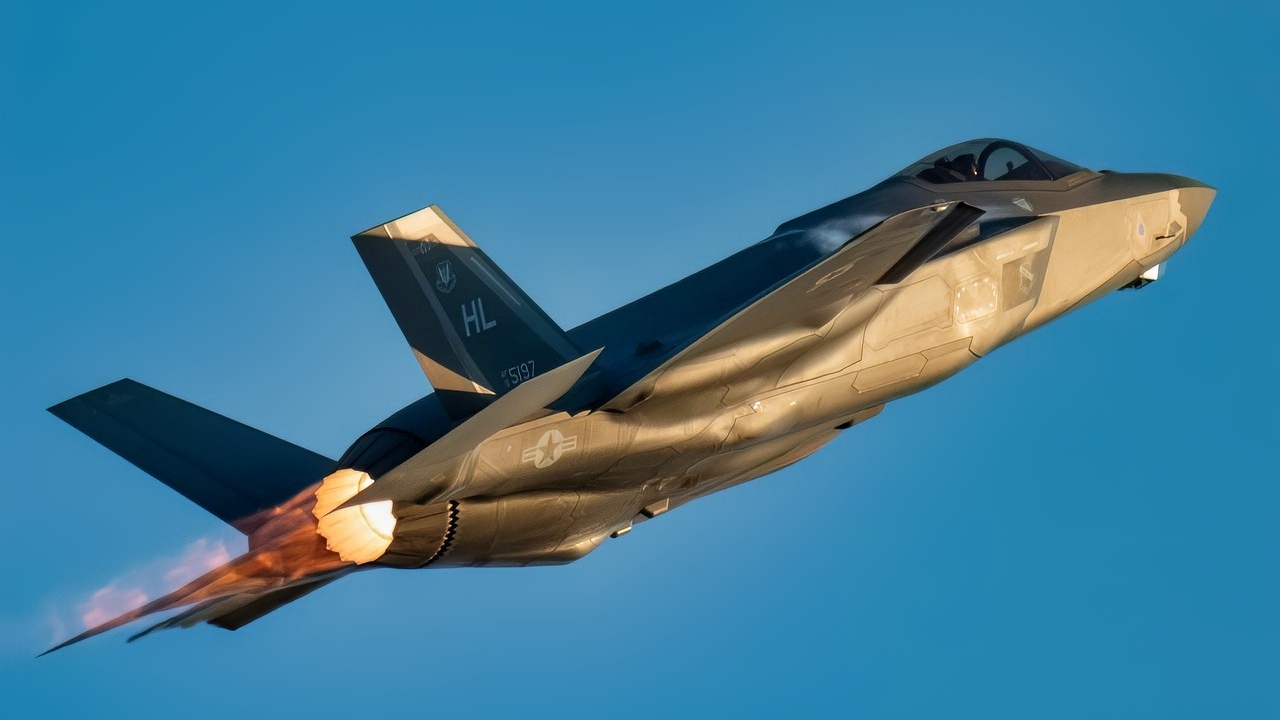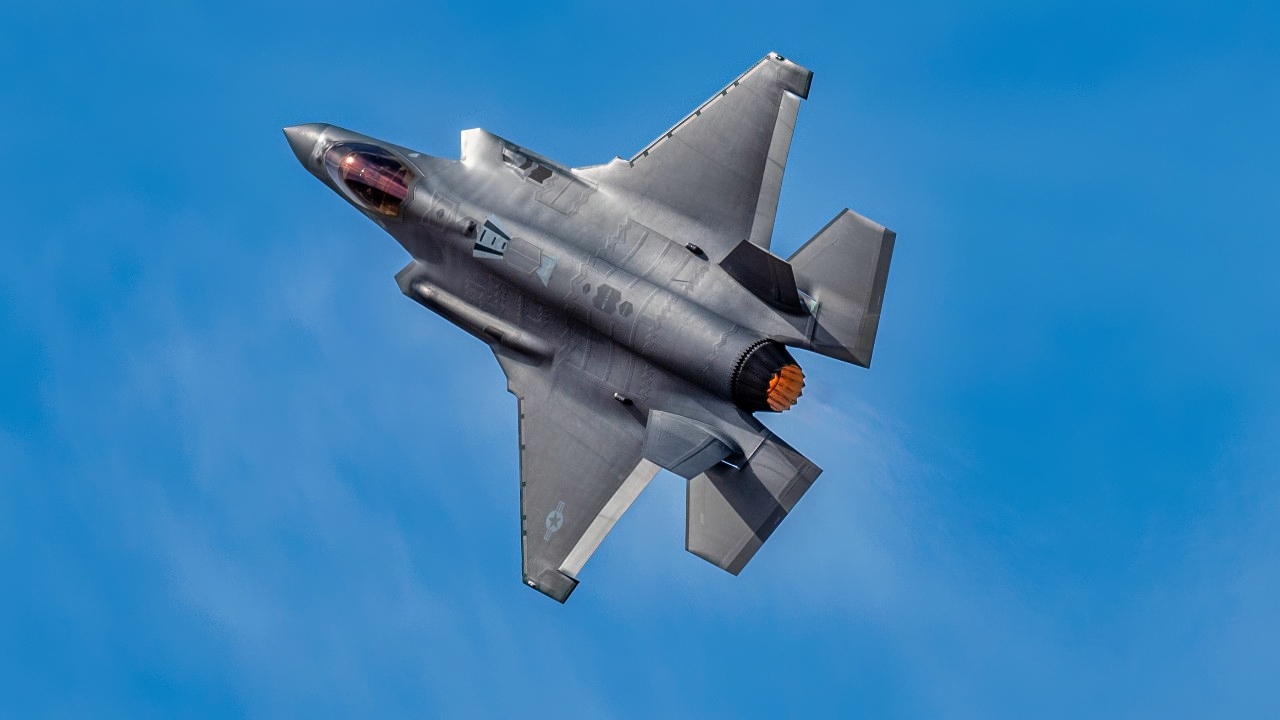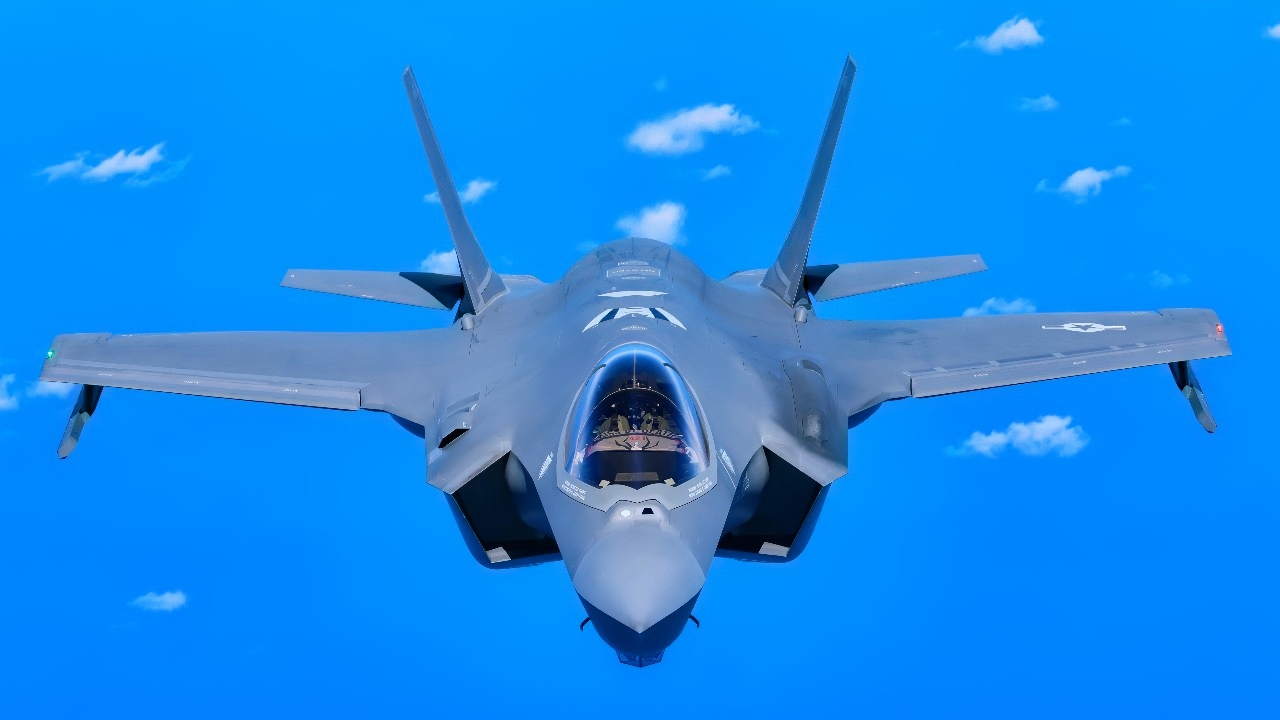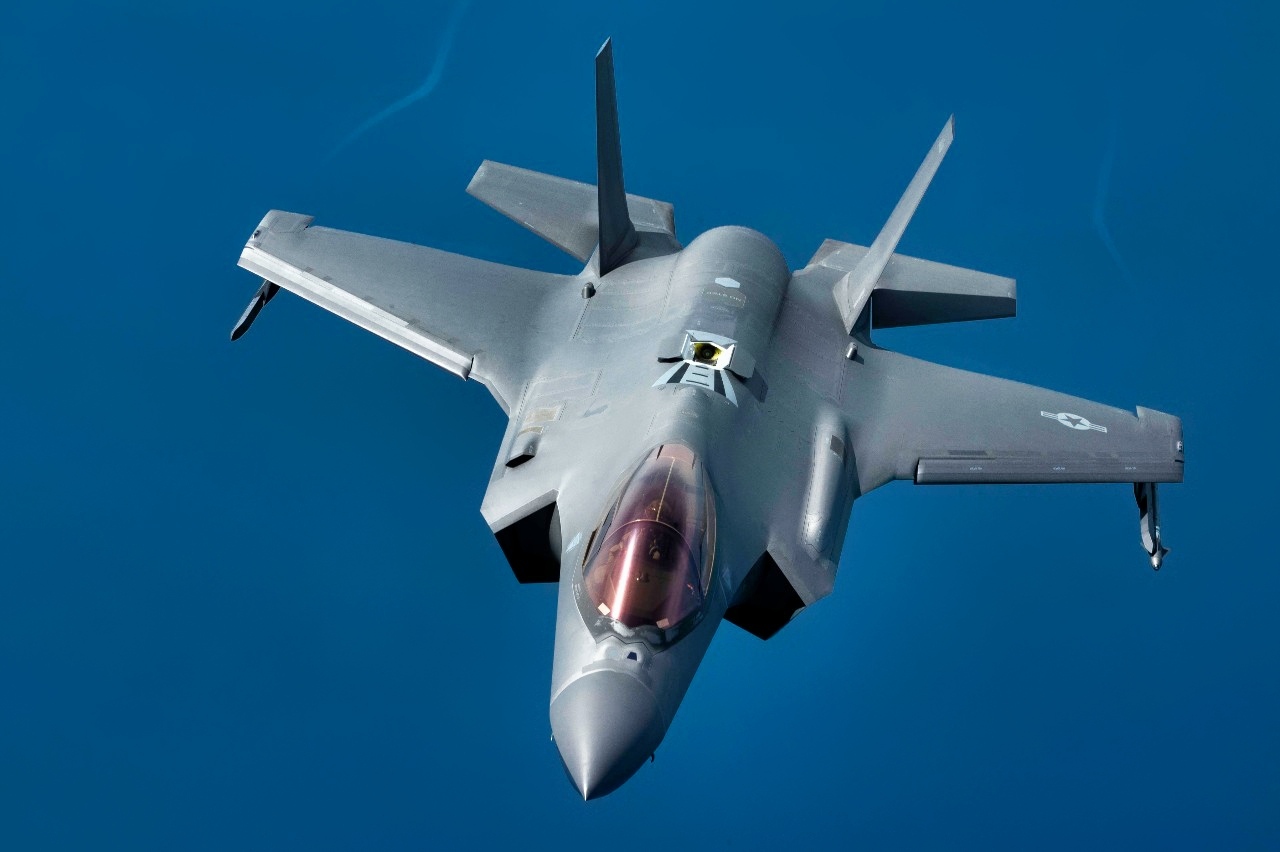Key Points and Summary – A new report from the Canadian Forces College warns that the F-35’s high sustainment costs and poor mission-capable rates (only 36% for the F-35A in 2023) pose a “significant risk” to Canada.
-This report lands as Prime Minister Mark Carney’s government is already reviewing its 88-jet purchase.

U.S. Air Force Major Kristin “BEO” Wolfe, F-35A Lightning ll Demonstration Team pilot and commander, flies during sunset over Mathers Airport, Calif., Sept. 24th, 2021, at the California Capital Airshow. The team consists of approximately 15 total Airmen to include the pilot and commander, pilot safety officers, superintendent, team chief, maintenance Airmen, aircrew flight equipment specialists, and public affairs personnel. (U.S. Air Force photo by Staff Sgt. Thomas Barley)

A U.S. Air Force F-35A Lightning II aircraft flies during the Heritage Flight Training Course at Davis-Monthan Air Force Base, Arizona, Feb. 28, 2025. The F-35 is designed to provide the pilot with unsurpassed situational awareness, positive target identification and precision strike in all weather conditions. (U.S. Air Force photo by Senior Airman Jasmyne Bridgers-Matos)
-The review is complicated by a trade dispute with the U.S. and a competing offer from Sweden’s Saab, which has promised to build its Gripen fighters in Canada, creating 6,000 jobs.
-While the Royal Canadian Air Force still favors the F-35 for NATO interoperability, the government’s final decision remains unannounced.
New Report Suggests F-35s Will Cost Too Much for Canada
A new report published by the Canadian Forces College argues that rising costs for the U.S.-made F-35 could become a significant problem for the Canadian military.
The authors say that F-35 jets could become a strain due to their maintenance demands and the difficulty of obtaining spare parts.
The news comes as the Canadian government continues to mull proceeding with the purchase of the remaining 72 aircraft, initially anticipated as part of a deal with Lockheed Martin in January 2023.
According to the anonymous author, F-35 jets require extensive support equipment, and difficulties in obtaining spare parts and handling maintenance could impact the fleet’s readiness.
“The F-35A program presents both substantial promise but with notable challenges for the RCAF as it moves toward the aircraft’s introduction to service and subsequent declaration of IOC,” the paper explains.
The author goes on to argue that poor parts management and maintenance could pose risks to operational readiness if not properly addressed.

Six F-35 Lightning ii aircraft follow closely behind a KC-135 stratotanker aircraft during a trip across the pacific ocean, April 20, 2025. The KC-135 provided aerial refueling support, enabling the six F-35s to reach Guam and Japan for a military exercise. (U.S. Air National Guard photo by Tech. Sgt. Andrew Stover)
“The sustainment challenges with spares management, maintenance complexities and overall logistics footprint may induce risks to the platform’s operational effectiveness, if not suitably resolved by the JPO or mitigated by the RCAF. Despite improvements in aircraft capabilities within the Block 4 standard, ongoing sustainment challenges continue to impact platform availability and mission readiness across the global fleet, with the F-35A in particular facing lower-than-expected mission capable rates and maintenance delays,” it reads.
While the author of the paper was not specified, it includes a statement that it was authored by a candidate attending the college in fulfillment of one of the requirements of their studies.
“The paper is a scholastic document, and thus contains facts and opinions which the author alone considered appropriate and correct for the subject,” the paper explains, adding that the opinions do not necessarily reflect the policy or opinion of any agency, including the Government of Canada and the Canadian Department of National Defence.
What Will Canada Do on F-35?
The report arrives as the Canadian government continues to actively re-examine its commitment to purchasing the whole fleet of 88 F-35A Lightning II jets from Lockheed Martin, with reports suggesting Ottawa might be leaning toward the Swedish JAS 39 Gripen as an alternative.
Under the Gripen proposal, Saab has offered to build or assemble any aircraft purchased by the Canadian government in Canada, with plans to partner with Canadian firms and find maintenance and sustainment solutions domestically.

A U.S. Air Force F-35 flies over the Gulf of Mexico during Checkered Flag 24-2, May 14, 2024. Checkered Flag, hosted by the 325th Fighter Wing, is one of the DoD’s largest air-to-air exercises and is designed to integrate 4th- and 5th-generation airframes to enhance mobility and employment capabilities of aviators and maintainers. The exercise responds to Air Combat Command’s plan to train the Immediate Response Force, a dedicated force for “rapid response” to unforeseen or unplanned operations. (U.S. Air Force photo by Staff Sgt. Jerreht Harris)
This alone has been one of the most attractive features of a deal with Saab, promising thousands of Canadian jobs and maintenance at home.
Still, while the prospect of new jobs could be compelling, the operational and logistical implications of switching platforms now are steep.
That being said, the offer is strong: Saab has guaranteed 6,000 Canadian jobs over 40 years, full assembly and sustainment in Canada, and the transfer of key aerospace IP to Canadian firms.
Moving away from the F-35 now after significant infrastructure upgrades, training commitments, and expenditure would undoubtedly raise costs and complexity.
And from the military’s standpoint, sticking with the F-35 still appears to be the most pragmatic route – even if Ottawa won’t say so. Canada already operates 16 F-35As under the current deal and has committed to pilot training and significant upgrades at bases like Cold Lake and Bagotville.
Many defense officials and the Royal Canadian Air Force continue to argue that maintaining a single-type fleet maximizes interoperability with the U.S. and NATO, and simplifies sustainment, logistics, and training.
Was This the Plan All Along?
The reconsideration of Canada’s F-35 deal also comes amid broader efforts by Ottawa to diversify its defense partnerships—or, more specifically, to depend less on the United States.
The Canadian government has held exploratory talks with the European Union on reducing long-term reliance on U.S. defense supplies since early this year.
The talks have also focused on broadening their industrial cooperation with European partners. Sources told Reuters that the discussions include joint procurement frameworks and potential participation in EU-backed defense-technology programs.
The review of the agreement appears not only financial but also political. The reassessment only appeared after a trade dispute between Prime Minister Mark Carney’s new government and U.S. President Donald Trump, who has threatened sweeping tariffs on Canadian products.
The timing raises questions over whether Ottawa’s renewed interest in the Swedish Gripen offer and other European options may simply be political, rather than a solid military calculation.
While the official review of the program is technically over, Ottawa has yet to announce any change to its fighter procurement plans – although that announcement could well be coming soon.
About the Author:
Jack Buckby is a British author, counter-extremism researcher, and journalist based in New York. Reporting on the U.K., Europe, and the U.S., he works to analyze and understand left-wing and right-wing radicalization, and reports on Western governments’ approaches to the pressing issues of today. His books and research papers explore these themes and propose pragmatic solutions to our increasingly polarized society. His latest book is The Truth Teller: RFK Jr. and the Case for a Post-Partisan Presidency.
*NOTE: This piece has been updated to fix a factual mistake regarding the F-35. Canada has, at present, purchased F-35s but is not operating them at the moment.
More Military
China’s New J-35 Navy Stealth Fighter Summed Up in 2 Words
China’s ‘Mighty Dragon’ J-20 Air Force Stealth Fighter Summed Up in 2 Words
China Is Trying to Turn the Indo-Pacific Into a Giant U.S. Navy ‘No-Go Zone’
$13 Billion Mistake? USS Gerald R. Ford Is the Navy’s Aircraft Carrier Agony
China’s ‘Thousands of Missiles’ Have a Message for U.S. Navy Aircraft Carriers











Bill G
October 28, 2025 at 10:49 am
Canada does not already operate 16 F-35A’s. When I see an egregious error of fact like this, I question the whole premise of the article even if it contains other pertinent information.
Thomas Buck
October 28, 2025 at 11:46 am
The statements that Canada is already operating F35s is false. While we have a contract to purchase some, nothing has been delivered. Given what the US is spirally down to, the F35 reliability issues and Saab’s offer to create 6000 jobs plus manufacturing and maintenance here it is foolhardy to continue down the F35 path.
Phantom Phixer
October 29, 2025 at 9:26 am
I sincerely hope that our neighbors to the north settle on and actually buy/acquire somewhat modern fighter aircraft. Be it American, or out of the EU. They currently operate some of the oldest platforms in the west.
Canadian politics have stalled more than one military acquisition program. In the interim other poor choices in Ottawa, have seen the retreat of the CAD against other world currencies. Making acquisition of just about anything much more expensive.
Then the politicians and the press spin stories about how difficult the American jet is to purchase/operate/maintain. When their commitment to NATO and the defense of North America could have already been fulfilled.
Whilst they now continue to kick the proverbial can down the road, their CAD continues to shrink of any purchasing power of any jet. Be it Swedish, EU or American.
Stop the lies and just buy.